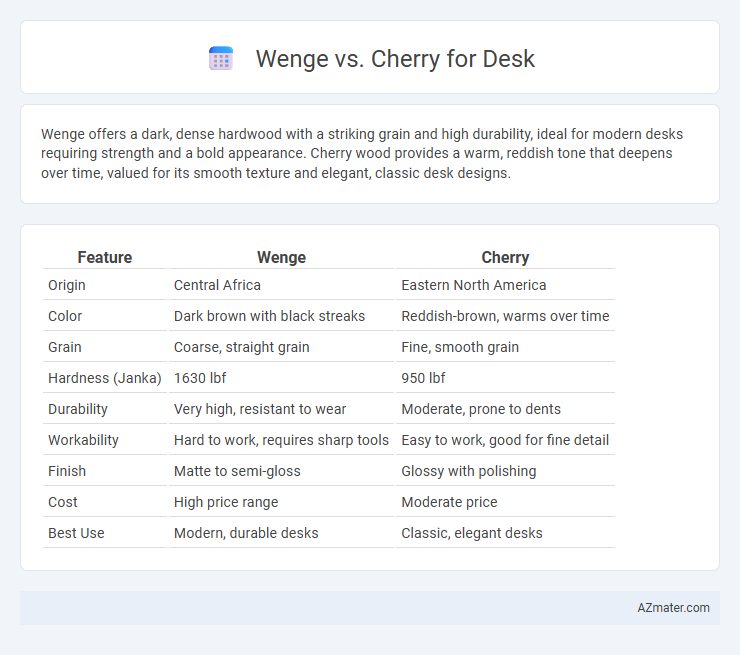Wenge offers a dark, dense hardwood with a striking grain and high durability, ideal for modern desks requiring strength and a bold appearance. Cherry wood provides a warm, reddish tone that deepens over time, valued for its smooth texture and elegant, classic desk designs.
Table of Comparison
| Feature | Wenge | Cherry |
|---|---|---|
| Origin | Central Africa | Eastern North America |
| Color | Dark brown with black streaks | Reddish-brown, warms over time |
| Grain | Coarse, straight grain | Fine, smooth grain |
| Hardness (Janka) | 1630 lbf | 950 lbf |
| Durability | Very high, resistant to wear | Moderate, prone to dents |
| Workability | Hard to work, requires sharp tools | Easy to work, good for fine detail |
| Finish | Matte to semi-gloss | Glossy with polishing |
| Cost | High price range | Moderate price |
| Best Use | Modern, durable desks | Classic, elegant desks |
Introduction to Wenge and Cherry Woods
Wenge wood, prized for its deep, rich brown color with subtle black streaks, offers exceptional density and durability, making it ideal for heavy-use desks. Cherry wood features a warm, reddish-brown hue that darkens gracefully over time, known for its smooth grain and fine texture. Both woods provide unique aesthetic and structural qualities, with Wenge's bold, exotic appearance contrasting Cherry's classic, elegant charm.
Appearance and Color Differences
Wenge wood features a deep, rich brown color with black streaks, creating a bold and dramatic appearance that adds a modern edge to desk designs. Cherry wood offers a warm, reddish-brown hue that deepens over time, providing a classic and elegant look with a smooth, fine grain. The darker and more textured look of Wenge contrasts sharply with Cherry's lighter, smoother surface, making the choice dependent on whether a contemporary or traditional desk aesthetic is preferred.
Grain Patterns and Texture
Wenge wood features a dark, dense grain with a straight to slightly interlocked pattern, offering a coarse texture that provides a visually striking, bold appearance for desks. Cherry wood displays a fine, uniform grain with occasional small knots, resulting in a smooth texture and a warm, reddish-brown tone that deepens beautifully over time. Choosing between Wenge and Cherry depends on desired aesthetics: Wenge's dramatic grain and texture suit modern, contrasting designs, while Cherry's subtle grain and smooth feel align with classic, elegant desk styles.
Durability and Hardness Comparison
Wenge wood is known for its exceptional hardness, rating around 4 on the Janka hardness scale with approximately 1630 lbf, making it highly resistant to dents and scratches, ideal for durable desk surfaces. Cherry wood, while softer with a Janka rating near 2.5 (950 lbf), offers moderate hardness but excels in aging beautifully with rich patina over time, enhancing aesthetic value rather than raw durability. For desk construction prioritizing longevity and resistance to wear, Wenge provides superior durability and hardness compared to Cherry, which favors elegance and softer handling.
Workability and Ease of Crafting
Wenge wood offers exceptional workability due to its dense, fine grain, allowing precise cuts and smooth finishes for desks, though its hardness may require sharper tools. Cherry wood, known for its moderate hardness and fine, straight grain, provides superior ease of crafting with minimal wear on tools and excellent shaping versatility. Both woods yield durable desks, but cherry is generally preferred for ease of sanding and carving during furniture making.
Maintenance and Care Requirements
Wenge wood requires regular dusting and occasional use of a damp cloth to maintain its dark, rich appearance, while avoiding excessive moisture to prevent warping. Cherry wood benefits from gentle cleaning and periodic application of wood polish or oil to enhance its natural reddish tone and protect the surface from drying out. Both woods need protection from direct sunlight and heat to preserve their finish and structural integrity over time.
Cost and Availability
Wenge wood typically commands a higher price due to its exotic origin and limited supply, making it less readily available compared to cherry wood, which is more abundant and sourced primarily from North America. Cherry wood desks offer a more cost-effective option without sacrificing durability or aesthetic appeal, benefiting from widespread availability that ensures quicker procurement. For budget-conscious buyers, cherry strikes the best balance between affordability and accessibility, while wenge caters to those seeking a unique, premium finish despite higher costs and longer lead times.
Environmental Impact and Sustainability
Wenge wood, sourced primarily from Central African rainforests, often raises concerns about deforestation and habitat loss due to illegal logging practices, making its environmental impact more severe compared to Cherry wood. Cherry wood, commonly harvested from sustainably managed forests in North America, generally supports better environmental practices by promoting responsible reforestation and biodiversity conservation. Choosing Cherry for desks aligns more closely with sustainability goals, offering a lower carbon footprint and enhanced forest stewardship certifications.
Best Applications for Desks
Wenge offers a deep, rich dark brown color with strong grain patterns, making it ideal for executive or luxury desks that require a sophisticated, professional appearance. Cherry wood provides a warm, reddish tone that deepens over time, perfect for home office desks where a classic, inviting ambiance is desired. Both woods are durable and sturdy, but Wenge's hardness suits heavy-use commercial desks, while Cherry's workability benefits custom, handcrafted desk designs.
Choosing the Right Wood for Your Desk
Wenge wood offers a deep, rich dark tone with exceptional durability, making it ideal for heavy-use desks that require both strength and a modern aesthetic. Cherry wood provides a warm reddish-brown color that ages beautifully with time, delivering a classic, elegant appearance suitable for traditional or refined office spaces. Selecting between Wenge and Cherry depends on your preference for either a bold, contemporary look with high resilience or a timeless, softer finish that develops character over years.

Infographic: Wenge vs Cherry for Desk
 azmater.com
azmater.com